Friday, 15 June 2012: Le Havre, Porte de l'Europe
Written 21 June 2012
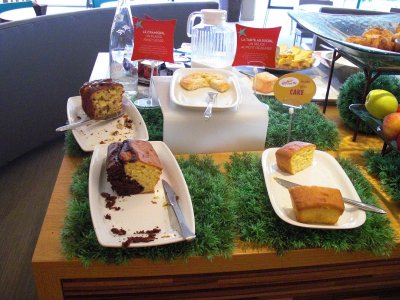
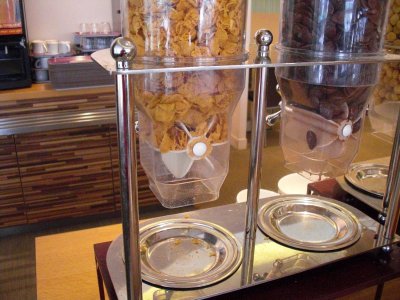 Breakfast at the Ibis included all the usual suspects (breads, viennoiseries, yogurt, fruit, ham cheeses—including an excellent pavée d'Auge—juices, plus some new choices, like these four kinds of cake, and a warming tray with small crepes and a Spanish potato tortilla.
Breakfast at the Ibis included all the usual suspects (breads, viennoiseries, yogurt, fruit, ham cheeses—including an excellent pavée d'Auge—juices, plus some new choices, like these four kinds of cake, and a warming tray with small crepes and a Spanish potato tortilla.
The configuration of the buffet let me get this shot illustrating the the design of the cereal dispensers. The diner places his bowl under the spout, then turns the silver handle on the front. The plastic paddle wheels you see here from the back act like a revolving door, scooping small portions from the hopper and dropping them into the bowl. Works like a charm for fine-grained cereals, like rice krispies and muesli, but cornflakes suffer major damage in the process.
Our objectives for the day were to visit the Office de Tourisme, to sign up for a boat tour of the harbor and port, to see the Musée André Malraux (modern art), and (if our feet and the weather permitted) to do at least some sort of walking tour of the city. When we finished breakfast, it was raining lightly but steadily, so we suited up, got out the car, and drove the mile and a half to the Office de Tourisme, where we learned that the boat tour was (unaccountably) not running that day; it would run again tomorrow, while we were on our way to Caen, but for the moment, they gave us a little map for a driving tour of the port by car. The only walking tours were self-guided—they gave us a leaflet and a little map indicating the route, which wound through the heart of the city, the portion designated a UNESCO World Heritage Site. The museum was the fourth stop on the tour, so we started off to cover the first three on the way there only to discover that Le Havre is a World Heritage Site of—are you ready? drum roll, please—1950's architecturea (as France's major port, the city was reduced to rubble by German bombs during WWII and was rebuilt, of course, in the 1950's). We tried to appreciate it; we really did, but we just couldn't get past the conclusion that it was like trekking from one to another five-story version of our elementary schools, which we found unsightly at the time and still do. At least they left out all the multicolored pastel panels between the windows, and nobody had taped crude paper cutouts of Thanksgiving turkeys and Easter eggs to the glass. The Michelin Guide gives it about a paragraph and calls it "an example of successful urban planning"—faint praise if ever I heard it.
So on to the museum, which was much better. It, too, claims to have the best collection of impressionists outside Paris, and this time we'd believe it. The building was 1950's but of the cable, glass, and steel style we liked so much in the Gallo-Roman museum in Vienne. It was well laid out, benefited from great natural light, and presented much worth seeing.
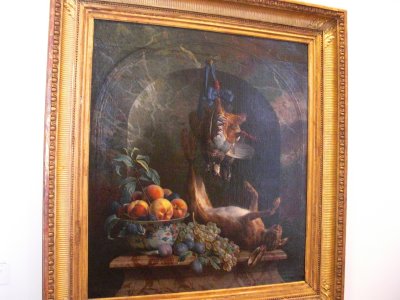
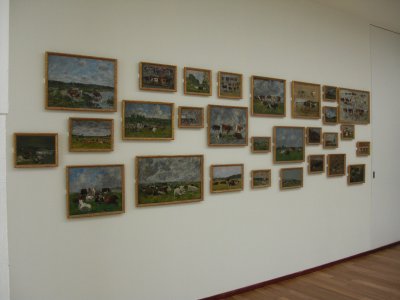 We (or at least CJ and I) started with the permanent collection, which included many works by familiar impressionists. Two pieces that I especially liked were this rather realisic still life of fruit and game by Francois Desportes (1661-1743) and this series of very impressionistic outdoor studies of animals, mostly cattle but also some geese and sheep, by Eugène Boudin. The museum has a particularly large collection of works by Boudin, a gift from his brother after the artist's death.
We (or at least CJ and I) started with the permanent collection, which included many works by familiar impressionists. Two pieces that I especially liked were this rather realisic still life of fruit and game by Francois Desportes (1661-1743) and this series of very impressionistic outdoor studies of animals, mostly cattle but also some geese and sheep, by Eugène Boudin. The museum has a particularly large collection of works by Boudin, a gift from his brother after the artist's death.
The grouping of animal studies is only part of a much longer series of such small paintings grouped at eye level the length of a very long wall.
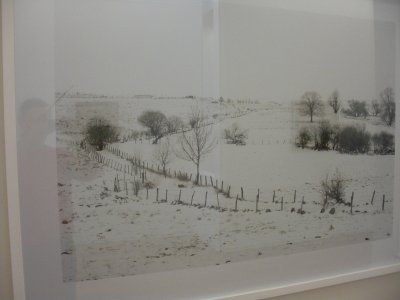
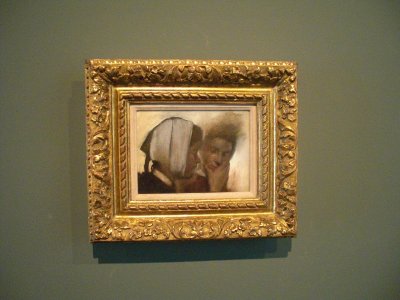 Another piece I lived was this 1958 snowscape by Thibaut Cuisset. From a distance I though it might be another Monet snowscape (we've seen several great ones this trip), but it turned out to be a photograph! Unfortunately, it's behind glass, so I couldn't get all the reflections out of the image, but I would love to have that in my living room.
Another piece I lived was this 1958 snowscape by Thibaut Cuisset. From a distance I though it might be another Monet snowscape (we've seen several great ones this trip), but it turned out to be a photograph! Unfortunately, it's behind glass, so I couldn't get all the reflections out of the image, but I would love to have that in my living room.
I was looking at something else when CJ came and got me—"You've got to come translate all this French and explain to me why this Dégas has a room all to itself." The painting is small, maybe 12 by 18 inches, and has traditionally been called "Laundresses suffering from toothache." It's part of the French national collection and was assigned during the 1970's to this museum. They hadn't had it two years before, one afternoon (a little after Christmas 1973, I think; they give the exact date), somebody apparently stuck it under his coat and walked out with it. After an initial demand for ransom, nothing more was heard, and the painting remained missing until someone spotted it in a lot coming up for sale at Sotheby's in 2010! Negotiations were undertaken, and the painting was returned, ending up back here in Le Havre in 2011. The painting was missing during a major 20-year restudy, revision, and rethinking of Dégas's work, so now it has to be fitted back into the art world's image of the artist. Modern opinion is that the women aren't laundresses and that toothache has nothing to do with it. CJ doesn't even think the one on the right is a woman.
Anyway, that's probably why all the painings in the museum are visibly bolted to the wall.
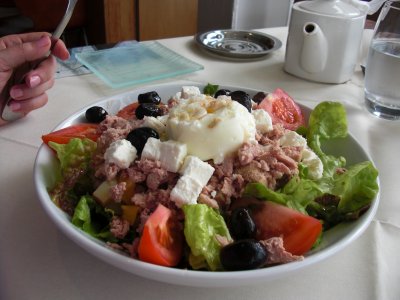
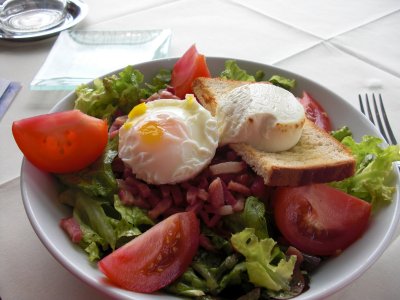 To save time and avoid going out in the rain, we had lunch in the museum's café, where we were apparently luck to get a table without a reservation. The one on the left is CJ's salade Niçoise (with potatoes, tuna, an egg, olives, and feta) and the on the right was my salade de chêvre (David had the same); they were okay but undistinguished.
To save time and avoid going out in the rain, we had lunch in the museum's café, where we were apparently luck to get a table without a reservation. The one on the left is CJ's salade Niçoise (with potatoes, tuna, an egg, olives, and feta) and the on the right was my salade de chêvre (David had the same); they were okay but undistinguished.
During lunch we had a view of the the cruise ship Costa Romantica (out of Genoa) and of the port's control tower (just across the street), shown below.
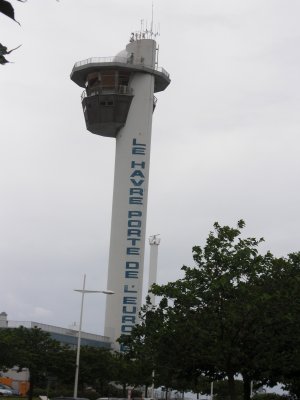
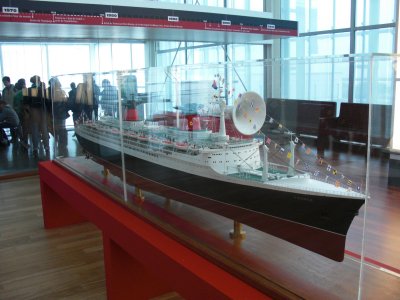 After lunch, we went on to the temporary exhibition, which filled about two-thirds of one of the two floors. Its subject was the ships of the golden age of trans-Atlantic ocean liners (or "paquebots" as the French call them, from the English "packet boat"). It focused primarily on the France and the Normandie, both of which were based in Le Havre.
After lunch, we went on to the temporary exhibition, which filled about two-thirds of one of the two floors. Its subject was the ships of the golden age of trans-Atlantic ocean liners (or "paquebots" as the French call them, from the English "packet boat"). It focused primarily on the France and the Normandie, both of which were based in Le Havre.
This model is of the France.
The exhibition was great. It included many, many photos of and details about the construction process and showed both cutaway and exploded views of the ships' structure—where the crew lived, where the salons and dining rooms were, what classes of passengers had cabins where. It also provided a very vivid picture of the various levels of luxury enjoyed by passengers in different classes. Even the "tourist" class was pretty classy.
Groups of period furniture and examples of the decor illustrated the styles of the various lounges and salons. It was all pretty resolutely Art Deco, the latest thing in the between-the-wars period when the ships were built.
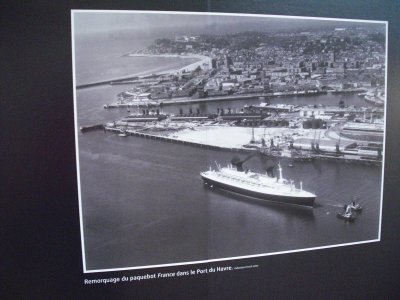
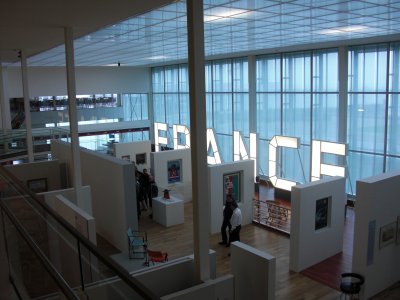 In this photo of the France being towed into Le Havre harbor, you can see the museum building. On the second spit of land from the camera, it's the low, flat, white-roofed building near the point (the control tower is also in there, but it's hard to see at this size). (Our restaurant of the previous evening was on the higher ground up on the fourth spit from the camera. Our hotel is out of the photo to the right.)
In this photo of the France being towed into Le Havre harbor, you can see the museum building. On the second spit of land from the camera, it's the low, flat, white-roofed building near the point (the control tower is also in there, but it's hard to see at this size). (Our restaurant of the previous evening was on the higher ground up on the fourth spit from the camera. Our hotel is out of the photo to the right.)
At the right is a view down into the exhibit from the museum's second floor. The large lighted letters are rather smaller than the real ones on the ship but give an idea of the effect. They even provided deck chairs around them that you could try sitting in.
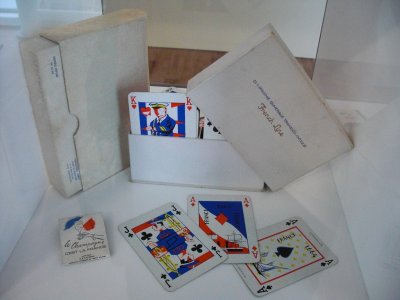
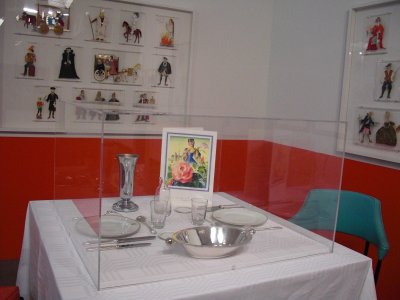 Here are some of the specially made playing cards the ship carried, in which the face cards are ship's officers.
Here are some of the specially made playing cards the ship carried, in which the face cards are ship's officers.
At the right is a sample place setting from the children's dining room, which was decorated with dozens of historical and story-book characters painted on raised glass panels. The punishment for ship's staff who broke rules was to be sent to serve in the children's dining room. Photos showed life in the children's play rooms, which included a cinema and a puppet theatre. The ship also provided full nursery facilities for younger children.
Written 30 June 2012
In one corner of the lower floor, behind a screen, a good deal of amplifier equipment was being set up, from which cables snaked here and there to strategically placed speakers. Some sort of concert must have been planned for later, which we missed, but we were treated to a brief sample, as a guy warmed up briefly on an amazing bass clarinet—what a voice that thing had!
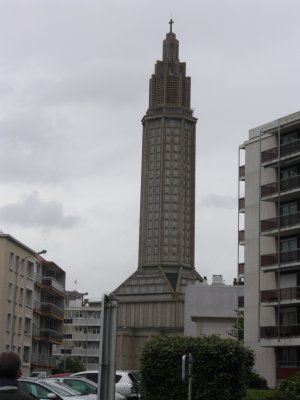
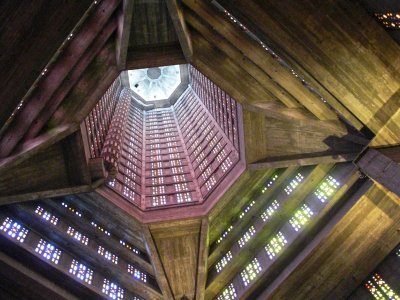 After we had exhausted the museum (well, not really of course, but we looked thoroughly at everything in it), we visited one more item on the walking tour, which happened to be on the way back to the car—the Church of St. Joseph. It's basically square, and the "body" of the church isn't much wider than the tower on top, which is described as "a physical and spiritual lighthouse" and is supposedly the last part of the city you can see as you head out to sea.
After we had exhausted the museum (well, not really of course, but we looked thoroughly at everything in it), we visited one more item on the walking tour, which happened to be on the way back to the car—the Church of St. Joseph. It's basically square, and the "body" of the church isn't much wider than the tower on top, which is described as "a physical and spiritual lighthouse" and is supposedly the last part of the city you can see as you head out to sea.
It's built almost entirely of reinforced concrete, which manages, from the inside to look surprisingly like wooden beams. In this view up the inside of the tower, you can see the cylinder that carries the spiral staircase to the top. CJ immediately had me ask whether she could climb it, but the answer was "not on your life!" It's used only for indispensable maintenance functions. A brochure explained all the symbolism in the structure (e.g., the abstract stained glass panels in all the walls differ subtly in color scheme, depending on the direction they face). My assessment is: "Much more attractive than you'd expect a 1950s-era reinforced concrete church to be."
From there, we embarked on the proposed driving tour of the port, only to get lost immediately in a maze of little roads and streets that the map omitted to show. Still we were able to spot some landmarks that appeared on the map and managed to get back on track see quite a lot. The first thing about the port of Le Havre is its size. It dwarfs the city. We probably drove 60 miles and only managed to loop around about half of it. Besides the many natural and artificial basins in the town itself, canals, inlets, and the Seine itself extend far inland (though not as far from the sea as you'd think; a channel that extends 15 miles eastward from the center of town may still only be three miles from the sea because it parallels the coast south of town. Multinational corporations have huge compounds staked out on these waterways, the largest being Total, whose gas stations you see all over France. Its wharves, tank farms, etc. occupy an area that's probably about the size of Le Havre itself. Here and there in the maze of roadways, you'd come to a crossroads with a little "town"—a couple of bars, a couple of restaurants, a barber, even a few houses. We had no idea!
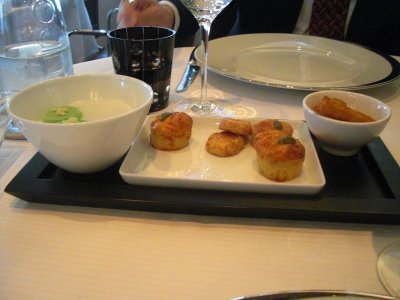
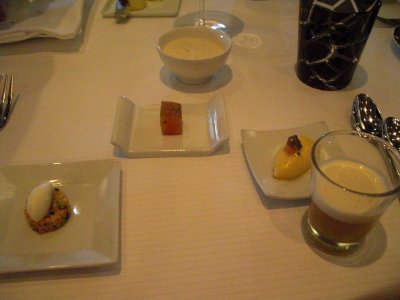 Dinner, reached on foot across the ruined wasteland of the tram-line construction, was at Jean-Luc Tartarin (a GM 4/5 like Gill), and here's where getting behind on the diary catches up with me. I have a copy of the menu to remind me of what each "real" course was, but the amuse-bouches and which cheeses we chose during the cheese course tend to run together after a while. Anyway, we ordered the tasting menu so we all ate the same things.
Dinner, reached on foot across the ruined wasteland of the tram-line construction, was at Jean-Luc Tartarin (a GM 4/5 like Gill), and here's where getting behind on the diary catches up with me. I have a copy of the menu to remind me of what each "real" course was, but the amuse-bouches and which cheeses we chose during the cheese course tend to run together after a while. Anyway, we ordered the tasting menu so we all ate the same things.
The first assortment, at the left, consisted of, from right to left, small, crispy deep-fried logs of something (perhaps duchesse potatoes); small olive-studded cakes and cheese shortbread cookies; and, in the taller white bowl, disks of green mustard icecream. The bottom of the bowl was filled with ice, which was topped with a disk of parchment paper on which reposed the bite-sized medallions of ice cream. Odd but good.
The second asortment was fivefold and intended to be eaten from left to right: (a) A little pressed disk of diced cooked vegetables with a small quenelle of something (I forget what!) on top. (b) A cube of dill-marinated raw tuna. (c) a creamy white soup. (d) Another quenelle of something topped with confit tomato and olive dice. (e) A warm cabbage soup topped with bacon-flavored foam.
With dinner came both miniature baguettes and round whole-grain breads, accompanied by a tall cone of salted butter and a flat disk of sweet butter.
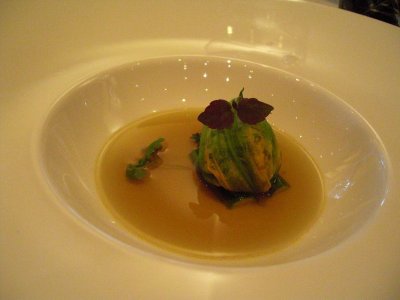
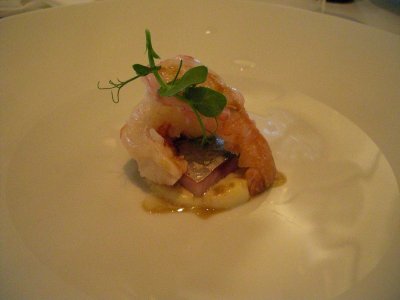 First course: A female zucchini flower stuffed with crab (tourteaux, Cancer pagurus). The baby zucchini attached to the flower had been split lengthwise to form a sort of raft for the stuffed flower, and it was all surrounded by a tasty, slightly spicy, crab broth.
First course: A female zucchini flower stuffed with crab (tourteaux, Cancer pagurus). The baby zucchini attached to the flower had been split lengthwise to form a sort of raft for the stuffed flower, and it was all surrounded by a tasty, slightly spicy, crab broth.
Second course: A langoustine tail, a medallion of lobster meat, and a square of boneless mackerel, all "just firmed up" in a little salted butter, perched on top of a purée of foie gras and potato with a shellfish emulsion and a pea sprout.
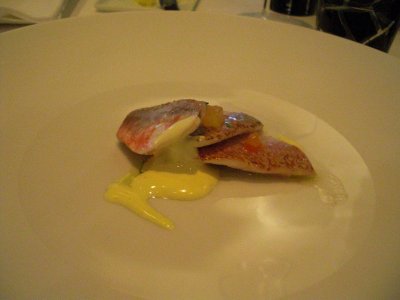
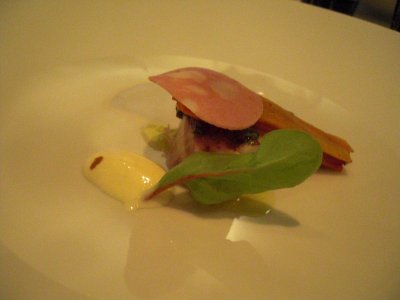 Third course: Filets of rougets de roches (red mullet, Mullus surmuletus,) rubbed with "black garlic" (which Wikipedia tells me is garlic cured for a month or so at high temperature in "extremely pure" seawater—isn't that like saying "an extremely pure mixture"?—until it turns black; a specialty of Aomori, Japan) with yellow, green, and red tomato and an emulsion of "herbaceous" olive oil. One of the best treatments of rouget I've ever eaten.
Third course: Filets of rougets de roches (red mullet, Mullus surmuletus,) rubbed with "black garlic" (which Wikipedia tells me is garlic cured for a month or so at high temperature in "extremely pure" seawater—isn't that like saying "an extremely pure mixture"?—until it turns black; a specialty of Aomori, Japan) with yellow, green, and red tomato and an emulsion of "herbaceous" olive oil. One of the best treatments of rouget I've ever eaten.
Fourth course: Wild bar (sea bass, Dicentrarchus labrax) cooked slowly at 38°C, cream of "Burrata" (a creamy mozzarella-based Italian cheese) and "veil" of mortadella.
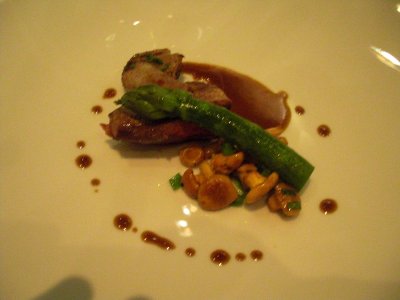
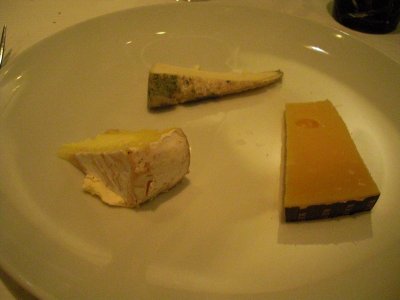 Fifth course: Pigeon cooked on a bed of hay (for the flavor) served with chanterelle mushrooms, asparagus, and the cooking juices.
Fifth course: Pigeon cooked on a bed of hay (for the flavor) served with chanterelle mushrooms, asparagus, and the cooking juices.
Sixth course: Cheese. I chose an ashed Pouligny St. Pierre (back), a Neufchatel (I think, left), and an outstanding aged gouda.
The mignardises, which arrived at this point, were tall, skinny pastry straws standing in a glass of cookie crumbs; little financière cakes, and tiny pots of baked custard.
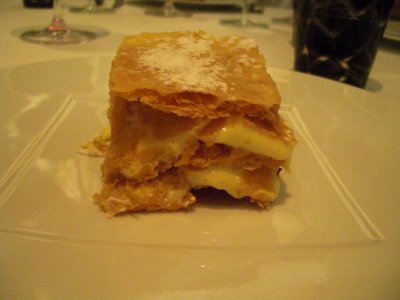
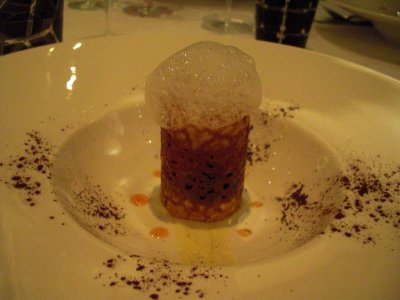 First dessert: Another vanilla millefeuille, and good as were the ones we'd had so far, this one blew them all out of the water. It was soooo good!
First dessert: Another vanilla millefeuille, and good as were the ones we'd had so far, this one blew them all out of the water. It was soooo good!
Second dessert: A sugar-lattice tube filled strawberries and raspberries topped with pistachio ice cream (replaced with vanilla in the one for CJ) and strawberry sorbet. Yum.
This dinner may get "best complete meal of the trip." The wine list did not include half bottles, so David and CJ ordered both a full bottle of white for the early courses and a full bottle of red for the later ones, planning to leave some behind, but both were so good that they drank all of both (plus the usual "coupe de champagne" with which they always begin)! Granted, it was over a period of three hours, but a good time was had by all. If the management had turned the AC on about an hour earlier, it would have been perfect.
previous entry
List of Entries
next entry

 Breakfast at the Ibis included all the usual suspects (breads, viennoiseries, yogurt, fruit, ham cheeses—including an excellent pavée d'Auge—juices, plus some new choices, like these four kinds of cake, and a warming tray with small crepes and a Spanish potato tortilla.
Breakfast at the Ibis included all the usual suspects (breads, viennoiseries, yogurt, fruit, ham cheeses—including an excellent pavée d'Auge—juices, plus some new choices, like these four kinds of cake, and a warming tray with small crepes and a Spanish potato tortilla. 
 We (or at least CJ and I) started with the permanent collection, which included many works by familiar impressionists. Two pieces that I especially liked were this rather realisic still life of fruit and game by Francois Desportes (1661-1743) and this series of very impressionistic outdoor studies of animals, mostly cattle but also some geese and sheep, by Eugène Boudin. The museum has a particularly large collection of works by Boudin, a gift from his brother after the artist's death.
We (or at least CJ and I) started with the permanent collection, which included many works by familiar impressionists. Two pieces that I especially liked were this rather realisic still life of fruit and game by Francois Desportes (1661-1743) and this series of very impressionistic outdoor studies of animals, mostly cattle but also some geese and sheep, by Eugène Boudin. The museum has a particularly large collection of works by Boudin, a gift from his brother after the artist's death. 
 Another piece I lived was this 1958 snowscape by Thibaut Cuisset. From a distance I though it might be another Monet snowscape (we've seen several great ones this trip), but it turned out to be a photograph! Unfortunately, it's behind glass, so I couldn't get all the reflections out of the image, but I would love to have that in my living room.
Another piece I lived was this 1958 snowscape by Thibaut Cuisset. From a distance I though it might be another Monet snowscape (we've seen several great ones this trip), but it turned out to be a photograph! Unfortunately, it's behind glass, so I couldn't get all the reflections out of the image, but I would love to have that in my living room.
 To save time and avoid going out in the rain, we had lunch in the museum's café, where we were apparently luck to get a table without a reservation. The one on the left is CJ's salade Niçoise (with potatoes, tuna, an egg, olives, and feta) and the on the right was my salade de chêvre (David had the same); they were okay but undistinguished.
To save time and avoid going out in the rain, we had lunch in the museum's café, where we were apparently luck to get a table without a reservation. The one on the left is CJ's salade Niçoise (with potatoes, tuna, an egg, olives, and feta) and the on the right was my salade de chêvre (David had the same); they were okay but undistinguished.
 After lunch, we went on to the temporary exhibition, which filled about two-thirds of one of the two floors. Its subject was the ships of the golden age of trans-Atlantic ocean liners (or "paquebots" as the French call them, from the English "packet boat"). It focused primarily on the France and the Normandie, both of which were based in Le Havre.
After lunch, we went on to the temporary exhibition, which filled about two-thirds of one of the two floors. Its subject was the ships of the golden age of trans-Atlantic ocean liners (or "paquebots" as the French call them, from the English "packet boat"). It focused primarily on the France and the Normandie, both of which were based in Le Havre.
 In this photo of the France being towed into Le Havre harbor, you can see the museum building. On the second spit of land from the camera, it's the low, flat, white-roofed building near the point (the control tower is also in there, but it's hard to see at this size). (Our restaurant of the previous evening was on the higher ground up on the fourth spit from the camera. Our hotel is out of the photo to the right.)
In this photo of the France being towed into Le Havre harbor, you can see the museum building. On the second spit of land from the camera, it's the low, flat, white-roofed building near the point (the control tower is also in there, but it's hard to see at this size). (Our restaurant of the previous evening was on the higher ground up on the fourth spit from the camera. Our hotel is out of the photo to the right.) 
 Here are some of the specially made playing cards the ship carried, in which the face cards are ship's officers.
Here are some of the specially made playing cards the ship carried, in which the face cards are ship's officers.
 After we had exhausted the museum (well, not really of course, but we looked thoroughly at everything in it), we visited one more item on the walking tour, which happened to be on the way back to the car—the Church of St. Joseph. It's basically square, and the "body" of the church isn't much wider than the tower on top, which is described as "a physical and spiritual lighthouse" and is supposedly the last part of the city you can see as you head out to sea.
After we had exhausted the museum (well, not really of course, but we looked thoroughly at everything in it), we visited one more item on the walking tour, which happened to be on the way back to the car—the Church of St. Joseph. It's basically square, and the "body" of the church isn't much wider than the tower on top, which is described as "a physical and spiritual lighthouse" and is supposedly the last part of the city you can see as you head out to sea.
 Dinner, reached on foot across the ruined wasteland of the tram-line construction, was at Jean-Luc Tartarin (a GM 4/5 like Gill), and here's where getting behind on the diary catches up with me. I have a copy of the menu to remind me of what each "real" course was, but the amuse-bouches and which cheeses we chose during the cheese course tend to run together after a while. Anyway, we ordered the tasting menu so we all ate the same things.
Dinner, reached on foot across the ruined wasteland of the tram-line construction, was at Jean-Luc Tartarin (a GM 4/5 like Gill), and here's where getting behind on the diary catches up with me. I have a copy of the menu to remind me of what each "real" course was, but the amuse-bouches and which cheeses we chose during the cheese course tend to run together after a while. Anyway, we ordered the tasting menu so we all ate the same things.
 First course: A female zucchini flower stuffed with crab (tourteaux, Cancer pagurus). The baby zucchini attached to the flower had been split lengthwise to form a sort of raft for the stuffed flower, and it was all surrounded by a tasty, slightly spicy, crab broth.
First course: A female zucchini flower stuffed with crab (tourteaux, Cancer pagurus). The baby zucchini attached to the flower had been split lengthwise to form a sort of raft for the stuffed flower, and it was all surrounded by a tasty, slightly spicy, crab broth.
 Third course: Filets of rougets de roches (red mullet, Mullus surmuletus,) rubbed with "black garlic" (which Wikipedia tells me is garlic cured for a month or so at high temperature in "extremely pure" seawater—isn't that like saying "an extremely pure mixture"?—until it turns black; a specialty of Aomori, Japan) with yellow, green, and red tomato and an emulsion of "herbaceous" olive oil. One of the best treatments of rouget I've ever eaten.
Third course: Filets of rougets de roches (red mullet, Mullus surmuletus,) rubbed with "black garlic" (which Wikipedia tells me is garlic cured for a month or so at high temperature in "extremely pure" seawater—isn't that like saying "an extremely pure mixture"?—until it turns black; a specialty of Aomori, Japan) with yellow, green, and red tomato and an emulsion of "herbaceous" olive oil. One of the best treatments of rouget I've ever eaten.
 Fifth course: Pigeon cooked on a bed of hay (for the flavor) served with chanterelle mushrooms, asparagus, and the cooking juices.
Fifth course: Pigeon cooked on a bed of hay (for the flavor) served with chanterelle mushrooms, asparagus, and the cooking juices.
 First dessert: Another vanilla millefeuille, and good as were the ones we'd had so far, this one blew them all out of the water. It was soooo good!
First dessert: Another vanilla millefeuille, and good as were the ones we'd had so far, this one blew them all out of the water. It was soooo good!